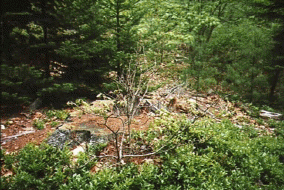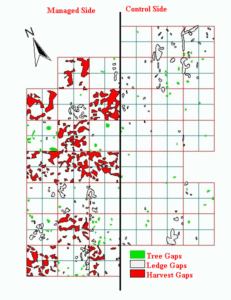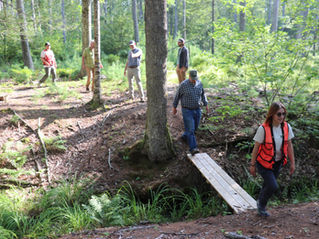
%20.png)
The Holt Research Forest is the site of long-term forest ecosystem research in Arrowsic, Maine. Maine TREE acquired the 350-acre property in 2014 through a merger with the Holt Woodland Research Foundation. The woods are predominantly a dry ridge, oak-pine ecosystem in Maine’s coastal climatic and midcoast biophysical regions.
Arrowsic is similar to the peninsulas found throughout Maine’s Mid-coast region. However, it’s an island surrounded by the Kennebec, the Sasanoa, and the Back Rivers in Maine’s coastal climatic region, and the midcoast biophysical region is the island. This region has the greatest woody plant species richness in the state partly because it falls within the transition between the Northeastern coastal forest to the west and south and the New England/Acadian forest to the east and north. The soils are derived from shallow glacial deposits on ridges and deep glaciomarine sediments in low-lying areas.
Featured Research
Forest Ecology
Since 1983, we have extensively monitored tree growth and health. Research at the site explores how timber harvests and climate change influence tree growth, regeneration, and species composition. This work provides valuable insights into forest resiliency and sustainability.
Wildlife
We collectdata on birds, salamanders, and small mammals to document their long-term trends and study the impacts of timber harvests on these populations. Our research suggests that wildlife species have wide-ranging effects on forest ecology and respond differently to various harvest methods.
Climate Change
Our research informs the management decisions of small woodlot owners and forest-based communities in Maine. The site's management goals aim to increase forest resiliency to climate change. Timber harvests can enhance forest resiliency by increasing species and structural diversity, thus helping the forest adapt to climate change

Within the study area, the blocks are further subdivided into 0.25 ha “quadrats” and 0.0625 ha “subquadrats.” The grid system provides excellent ground resolution as a “known” point at most 25 meters away.
A grid system has been superimposed over the Holt Research Forest. The entire property is divided into 1-hectare “blocks.” The main study area consists of a central 40-ha (about 100 acres) area between Old Stage Road and the Back River to the east.


Harvest Design
1987-1998
Within the 120 hectare (300 acre) Holt Research Forest, we selected a 40 hectare (100 acre) study area. The study area is located on the eastern half of the property, between Old Stage Road to the west and the Back River to the east. We divided the study area into 40 one-hectare (0.4 acre) blocks, then subdivided each block resulting in 160 50×50 meter quadrats, and 640 25×25 meter subquadrats. We bisected the study area along a north-south line into a “managed” half on the west and a “control” half on the east. We also established “buffer” blocks around the study area.
In the winter of 1987-88, we randomly selected and harvested 10 of the 1-ha blocks on the managed side. This harvest removed 44% of the basal area, including many large, poorly formed trees. It created openings in the canopy–harvest gaps–to release advanced regeneration and encourage new regeneration, thereby adding a new age class the forest. See Research – Forest Canopy Gaps for more details. Thus we were on our way to meeting our forest management objectives to increase structural habitat diversity by adding a new vertical layer of vegetation, and arrive at a more balanced age-class distribution to generate an even flow of forest products over time. We believed that the small gap sizes minimized the loss of near-term aesthetic appeal while enhancing the beauty of the forest over the long run. Subsequent monitoring and research on both the managed and control sides is giving us data to interpret the effects of forest management on various ecosystem components.

News from the Forest
Outreach & Education
The purpose of outreach and education at the Holt Research Forest is to teach principles of forest ecology and to share research results with people making management decisions on Maine’s non-industrial forests, thus closing the gap between the knowledge gained through research and real-world practice.

Work at the Holt Research Forest is dedicated to
Dr. William L. Holt Jr.
his wife, Winifred Holt
and their son, F. Rodney Holt.
These family members were the impetus for the creation of the Holt Woodlands Research Foundation and the Holt Research Forest. The Holts’ generosity, foresight, and commitment to forest research have been demonstrated repeatedly over the many years of this project.
Their past support of the Holt Research Forest has and will continue to provide benefits to students, logging, forestry, and wildlife professionals, forest landowners, and forest management in Maine. To this end, they have served us all.

.jpg)
































